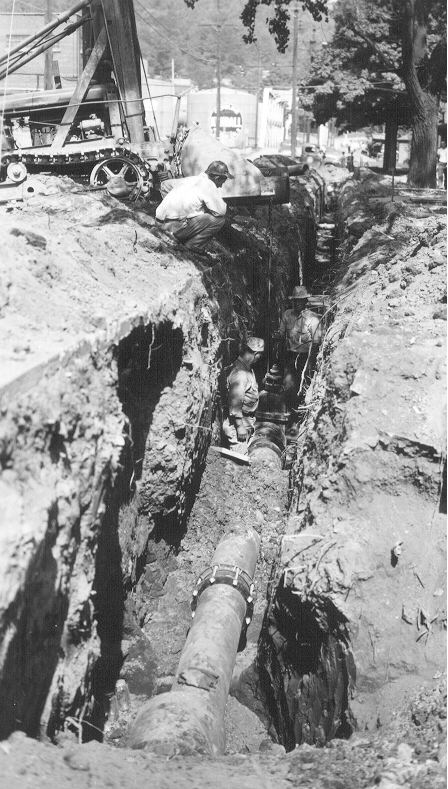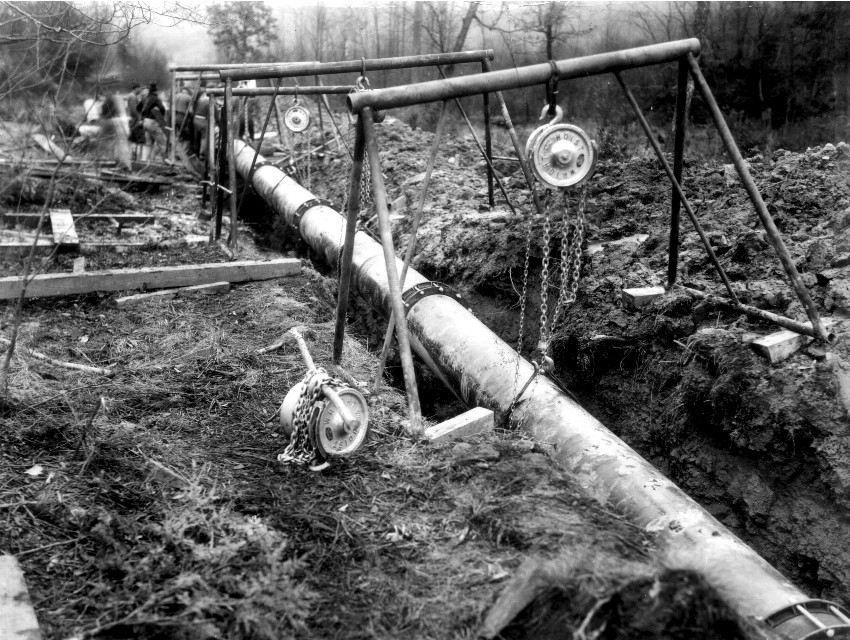A Brief History
Prior to 1910, the Marilla Brook Reservoir was constructed and a 14-inch transmission line was extended from the reservoir to the city. This reservoir was reconstructed and raised in elevation in the 1920’s.
In 1909 Reservoir Number 4 was constructed on Newell Hill adjacent to the city and lines were extended to this reservoir. The purpose of this reservoir, having a capacity of 3.5 million gallons, was to provide the city with some source of water supply should the transmission mains rupture between the upland reservoirs and the city.
In 1938 a 20-inch main was extended from the Gilbert Run Reservoir to Reservoir Number 4 near the city. This transmission main was interconnected with the 12-inch Gilbert Run main and the 14-inch Marilla Brook line at a point along West Washington Street where the two older lines came together.
During the 1930’s the available supply from the two upland reservoirs could no longer keep up with the water demands of the city. Therefore, wells were drilled to augment the existing surface water supply. Water produced by these wells was quite different than the supply the residents of Bradford had become accustomed to over the years which led to a multitude of consumer complaints. Basically, water produced by the wells was moderately hard, contained quantites of iron and manganese and, it is reported, the wells were subject to some salt-water intrusion when pumped on a continuous basis.
During the 1940’s, a series of test wells were drilled at various points throughout portions of the distribution system where sand and gravel deposits were known to exist. The results of all of the exploratory work did not yield any site suitable for the development of permanent wells because of low yield and poor quality of water produced by the test wells.
Accordingly, a decision was made to construct additional surface water impoundments. In 1950, the city applied for and was granted water allocations to withdraw water from the North Branch of Sugar Run and the West Branch of Tunugnwant Creek. Following receipt of these allocations, persons involved with the operation of the water system became concerned that the proposed points of withdrawal might become contaminated from the upstream operation of portions of the Bradford Oil Fields. In 1955 the two points of water withdrawal were abandoned and a decision was made to construct a new reservoir on the West Branch of the Tunungwant Creek above Kissem Run. This is the site of Reservoir Number 5, now known as Heffner Reservoir.
When it came time to acquire land and construct the Heffner Reservoir, the City of Bradford recognized that it did not have sufficient financial resources to construct a facility of the magnitude being proposed. Therefore, in 1955 the Bradford City Water Authority was created and charged, as its initial project, with the acquistion of the land, planning and construction of the proposed new reservoir. The Authority began work by acquiring the site for the proposed new dam and most of the watershed above the dam site (approximately 7.0 square miles). Plans for the construction of the dam and a 24-inch transmission main extending to the city were also prepared.
When the Authority was ready to finance the construction of the project by the issuance of tax-free Authority Water Revenue Bonds, it was advised that in order to secure the investment of potential investors in the proposed bond issue, it would be necessary for the Authority to acquire the entire water supply system owned by the City of Bradford. Accordingly, the City deeded the entire water supply system to the Authority, and, at the same time, the Authority entered into a long-term lease with the city. Under the terms of this lease, the City was empowered to operate the water system as it always had done and to set rates of sufficient magnitude to generate cash to operate the system and to amortize the Authority Bond Issue.
The Bonds were issued by the Authority, the new reservoir and transmission main were constructied in 1956, pumping of the wells was terminated once the new supply was on line and the city operated the water system on a relatively routine basis, making all required payments to the Authority, until 1979.
In 1979, following the incidence of severe storms on the watershed, the water system was plagued with an outbreak of a water-borne disease known as giardiasis. This outbreak took place during times of high turbidity of the water delivered to the city as a result of the heavy storms. Prior to this outbreak, water from the three upland reservoirs was delivered directly to the consumer without any treatment other than chlorination as the water passed out of the reservoirs into the transmission mains.
Therefore, to ensure that no future outbreaks of disease would take place, plans were formulated to construct a water treatment plant to treat all water delivered to the city. As planned, this plant was to be capable of removing all micro-organisms from the water through the process of chemical treatment and filtration. As a secondary benefit, turbidity in the reservoir supply would be reduced to levels well within the requirements of the Safe Drinking Water Act.
During 1980 and 1981, studies were completed and decisions were made by the Authority which accepted data contained in the studies, and conclusions were reached to the effect that a water treatment plant would solve the majority of problems in evidence on the water system as related to water quality. A start of design was authorized. However, when it became evident that the water system consumers could not afford the original design concept, a second design concept was approved. The second design concept was completed, acceptable construction bids were received and the project was readily financed throught the issuance of Authority Revenue Bonds. The new facilities were constructed and placed in operation in September 1985. Presently, the new facility is meeting every criteria set forth by the Authority and is operating well within the rules promulgated by the U.S. Environmental Protection Agency and Pennsylvania Department of Environmental Protection.
During 1986, the City of Bradford and the Authority reached agreement to terminate the long-standing Agreement of Lease. Therefore, prior to the end of 1986, the Authority will be directly responsible for the entire operation of the water system serving the Greater Bradford Area.

